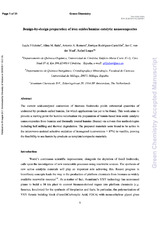Mostrar el registro sencillo del ítem
Benign-by-design preparation of iron oxides/humins catalytic nanocomposites
| dc.contributor.author | Filiciotto, Layla | |
| dc.contributor.author | Balu, Alina M. | |
| dc.contributor.author | Romero, Antonio A. | |
| dc.contributor.author | Rodríguez-Castellón, Enrique | |
| dc.contributor.author | Van der Waal, Jan Cornelis | |
| dc.contributor.author | Luque, Rafael | |
| dc.date.accessioned | 2019-11-07T12:17:32Z | |
| dc.date.available | 2019-11-07T12:17:32Z | |
| dc.date.issued | 2017 | |
| dc.identifier.uri | http://hdl.handle.net/10396/19065 | |
| dc.description.abstract | The current acid-catalyzed conversion of biomass feedstocks yields substantial quantities of undesired by-products called humins, for which applications are yet to be found. This work aims to provide a starting point for valorisation of humins via preparation of humin-based iron oxide catalytic nanocomposites from humins and thermally treated humins (foams) via solvent-free methodologies including ball milling and thermal degradation. The prepared materials were found to be active in the microwave-assisted selective oxidation of isoeugenol (conversions >87%) to vanillin, proving the feasibility to use humin by-products as template/composite materials. | es_ES |
| dc.format.mimetype | application/pdf | es_ES |
| dc.language.iso | eng | es_ES |
| dc.publisher | Royal Society of Chemistry | es_ES |
| dc.rights | https://creativecommons.org/licenses/by-nc-nd/4.0/ | es_ES |
| dc.source | Green Chemistry 19, 4423-4434 (2017) | es_ES |
| dc.subject | Catalytic materials | es_ES |
| dc.subject | Catalytic nanocomposites | es_ES |
| dc.subject | Biomass valorization | es_ES |
| dc.subject | Side-products | es_ES |
| dc.subject | Humins | es_ES |
| dc.title | Benign-by-design preparation of iron oxides/humins catalytic nanocomposites | es_ES |
| dc.type | info:eu-repo/semantics/article | es_ES |
| dc.relation.publisherversion | https://doi.org/ 10.1039/C7GC01405H | es_ES |
| dc.relation.projectID | info:eu-repo/grantAgreement/EC/H2020/675325 (HUGS) | es_ES |
| dc.relation.projectID | Gobierno de España. CTQ2015-68951-C3-3R | es_ES |
| dc.rights.accessRights | info:eu-repo/semantics/openAccess | es_ES |

